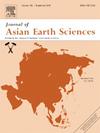泰国西部三塔切变带内的运动流动和温度变化
IF 2.7
3区 地球科学
Q2 GEOSCIENCES, MULTIDISCIPLINARY
引用次数: 0
摘要
通过分析麦饭石岩中矿物颗粒的变形,可以直接计算剪切带中的应变模式、涡度分析和变形温度。我们对泰国西部三塔剪切带的石英岩麦饭石岩进行了有限应变、流动涡度分析,并估算了变形温度。结果表明,中部剪切带的变形温度在 510 ℃ 至 570 ℃ 之间,西部和东部剪切带的变形温度在 320 ℃ 至 450 ℃ 之间。有限应变(Rs)从 1.86 到 2.63 不等。平均运动涡度数(Wm)采用两种不同的方法测定--斑岩长宽比(PAR)和刚性晶网(RGN)。Wm 值从 0.80 到 0.90 不等,其中简单剪切占 59% 到 71%,纯剪切占 29% 到 41%。对这些区域的比较表明,应变变化从东部区域向西部区域过渡,在接近中部区域时应变明显增加。西区的 S 值为 0.57 至 0.65,中区为 0.70 至 0.75,东区为 0.65 至 0.72。我们的研究结果证实,三塔剪切带的内部结构呈现异质性分布,表现为正弦转位滑动,剪切带中心有一般剪切和分布式简单剪切成分的应变分区。塔布西拉变质复合体的掘起和冷却很可能受到早新生代印度-欧亚大陆碰撞两个不同阶段的影响:早始新世转位,随后是晚始新世-早渐新世的击滑变形。本文章由计算机程序翻译,如有差异,请以英文原文为准。

Kinematic flow and temperature variation within the Three Pagodas shear Zone, western Thailand
The deformation of mineral grains in mylonitic rocks enables the direct calculation of strain patterns, vorticity analysis, and deformation temperatures in the shear zones. Quartzite mylonite rocks from the Three Pagodas shear zone, western Thailand, were analyzed for finite strain, flow vorticity, and estimate deformation temperatures. Our results indicate deformation temperatures ranging from 510 °C to 570 °C in the central zone, and from 320 °C to 450 °C in the western and eastern zones. The finite strain (Rs) varied from 1.86 to 2.63. Mean kinematic vorticity number (Wm) was determined using two different methods—the porphyroclast aspect ratio (PAR) and the rigid grain net (RGN). Wm values ranged from 0.80 to 0.90, with 59 % to 71 % simple shear and 29 % to 41 % pure shear. A comparison of these zones suggests a transition in strain variation from the eastern to the western zones, with a noticeable increase in strain approaching the central zone. The S values ranged from 0.57 to 0.65 in the western zone, 0.70 to 0.75 in the central zone, and 0.65 to 0.72 in the eastern zone. Our findings confirm that the internal structure of the Three Pagodas shear zone exhibits the heterogeneous distribution, demonstrating sinistral transpressional slip with strain partitioning of general shear and distributed simple shear components at the center of the shear zone. The exhumation and cooling of the Thabsila metamorphic complex were likely influenced by two distinct phases of the India-Eurasia collision during the Early Cenozoic: Early Eocene transpression followed by Late Eocene–Early Oligocene strike-slip deformation.
求助全文
通过发布文献求助,成功后即可免费获取论文全文。
去求助
来源期刊

Journal of Asian Earth Sciences
地学-地球科学综合
CiteScore
5.90
自引率
10.00%
发文量
324
审稿时长
71 days
期刊介绍:
Journal of Asian Earth Sciences has an open access mirror journal Journal of Asian Earth Sciences: X, sharing the same aims and scope, editorial team, submission system and rigorous peer review.
The Journal of Asian Earth Sciences is an international interdisciplinary journal devoted to all aspects of research related to the solid Earth Sciences of Asia. The Journal publishes high quality, peer-reviewed scientific papers on the regional geology, tectonics, geochemistry and geophysics of Asia. It will be devoted primarily to research papers but short communications relating to new developments of broad interest, reviews and book reviews will also be included. Papers must have international appeal and should present work of more than local significance.
The scope includes deep processes of the Asian continent and its adjacent oceans; seismology and earthquakes; orogeny, magmatism, metamorphism and volcanism; growth, deformation and destruction of the Asian crust; crust-mantle interaction; evolution of life (early life, biostratigraphy, biogeography and mass-extinction); fluids, fluxes and reservoirs of mineral and energy resources; surface processes (weathering, erosion, transport and deposition of sediments) and resulting geomorphology; and the response of the Earth to global climate change as viewed within the Asian continent and surrounding oceans.
 求助内容:
求助内容: 应助结果提醒方式:
应助结果提醒方式:


